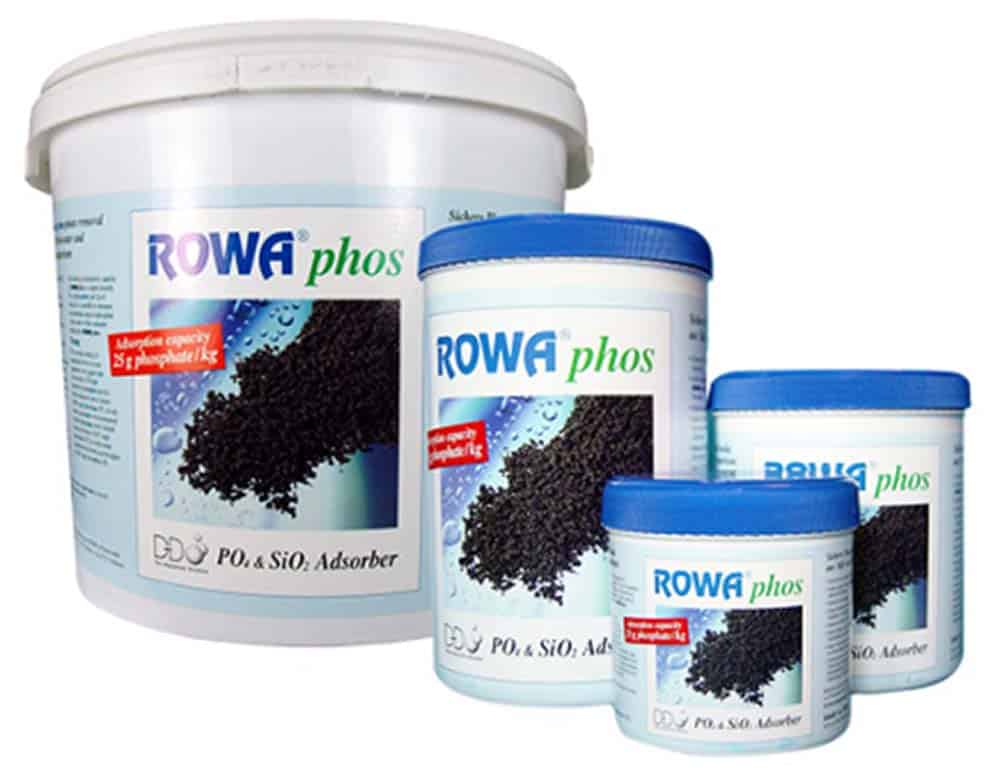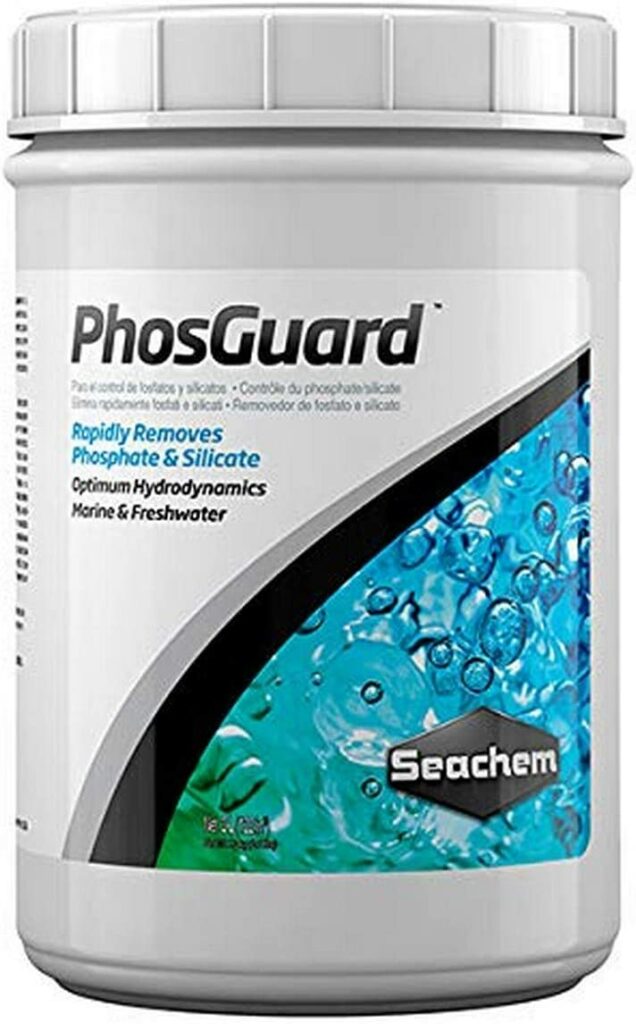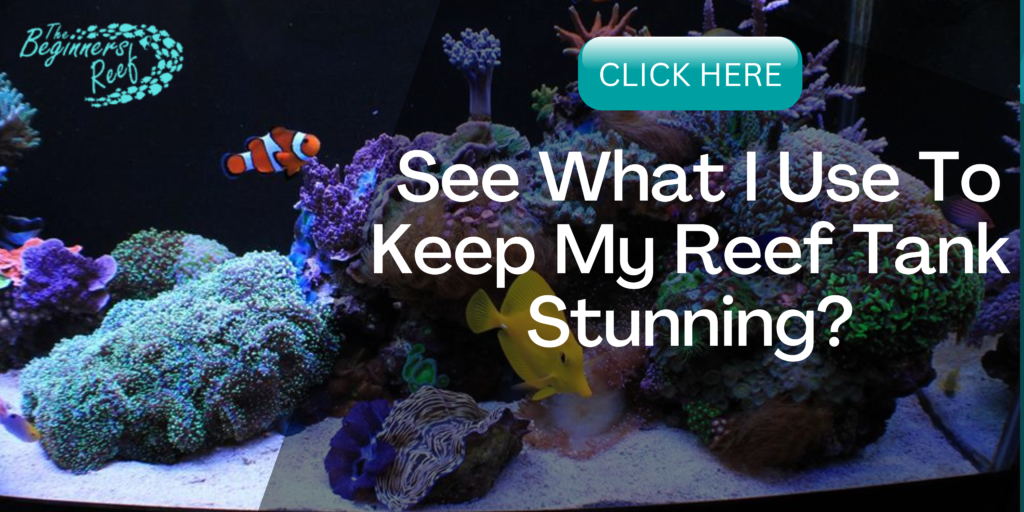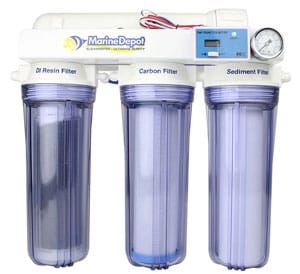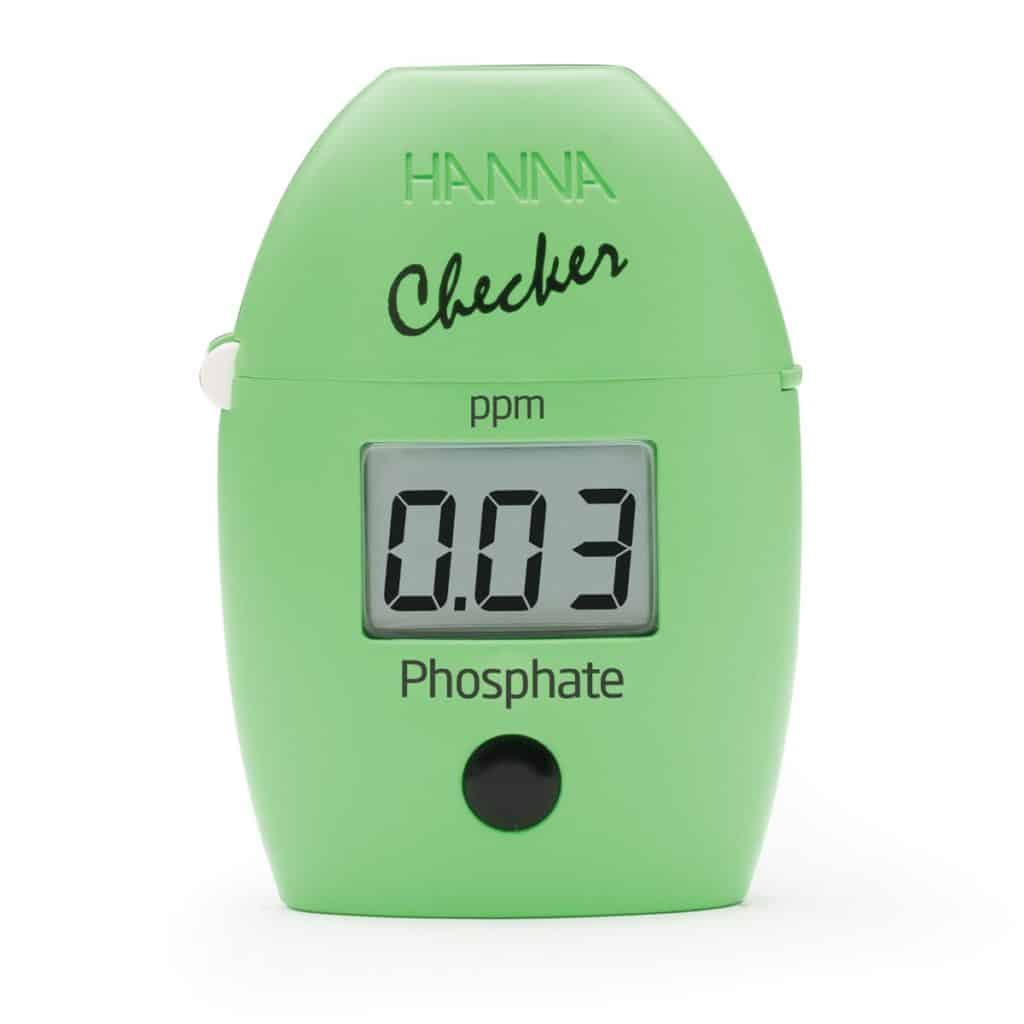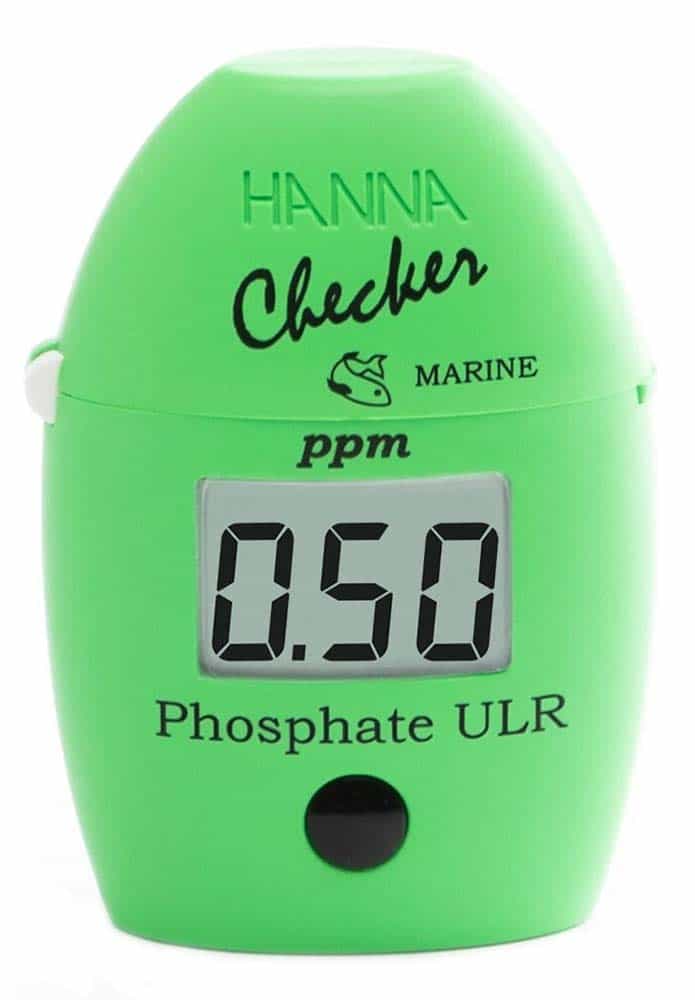Phosphate is an important but often overlooked parameter in a saltwater aquarium. High levels of phosphate can prevent the skeletal growth of coral and fuel horrendous algae blooms!
I had no idea about phosphate until my corals were not growing and a fellow reefer asked me what my phosphate level was! From that point on I soon found out how phosphate affected my aquarium!
Aquarium phosphate can be lowered using RO/DI filtered water, reduced feeding & fish stocking, regular maintenance & detritus removal, and liquid & granular binding products. Phosphate should be kept under 0.50ppm for fish-only tanks, 0.05ppm for mixed coral tanks, & 0.03ppm for SPS dominant tanks.
The best way to combat high levels of phosphate is a multi-angled approach after you have decided what the maximum level of phosphate can be tolerated by the type of aquarium you own.
What Should My Reef Tank Phosphate Level Be?
To ensure a healthy saltwater aquarium here is the recommended maximum phosphate level you should aim to keep your type of aquarium under:
| Aquarium Type | Max Phosphate Level |
|---|---|
| Fish-Only Tank | 0.50 ppm |
| Mixed Reef Tank | 0.05 ppm |
| SPS Dominant Tank | 0.03 ppm |
Be advised that you will need SOME phosphate in your aquarium to be used by your corals to grow, so going overboard and completely stripping your water of phosphate will have the same effect of slow coral growth as having too much! The key is to find a balance for your system, as every tank is different!
Now we have the limits recommended by the hobby in mind let’s look at what phosphate is, where it comes from, how it affects the tank, and how to manage it. If this interests you then please read on!
Ways To Lower Phosphate In a Saltwater Aquarium
There are four main ways to help lower the phosphate level in your aquarium:
1. Physical Removal
Your aquarium is an enclosed bio-system that will naturally build up phosphate over time. Phosphate introduced in water during initial fill and water changes, phosphate that was bound up in sand, rock, and coral skeletons begin to leach out, uneaten food, and fish poop begin to decay.
Each time you vacuum your sand bed, blast off crud settled in your rock with a turkey baster, and scrape your glass you are getting the phosphate-laden material into the water column and then physically removed when completing a water change. If you then replace that water with RO/DI filtered water, your phosphate level will reduce over time.
More Out, Than More In = Reducing Level of Phosphate!
2. A Protein Skimmer
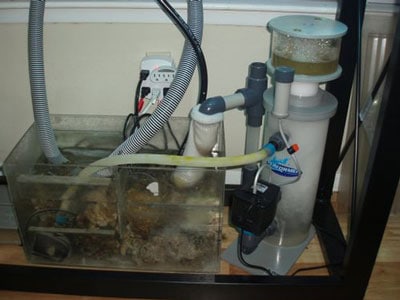
A correctly sized, clean and efficiently working protein skimmer is another great way to help keep phosphate low. The skimmer’s job is to remove Dissolved Organic Waste. Waste, as we know, breaks down and releases the phosphate bound up within it into the water.
By allowing your skimmer to move this waste into the collection cup and then emptying that cup, you have now removed that material before it has a chance to release the phosphates bound up within it back into the water.
3. Refugium or Turf Algae Scrubber
Algae is a wonderful consumer of phosphate and if you can spare the room, adding a Refugium and/or possibly an Algae Turf Scrubber to your system will greatly improve your phosphate reduction.
When you have an abundance of algae growing in your aquarium it is a sign that your phosphate and usually nitrate levels are high. These two elements are the food that algae feeds on.
Lots of Algae = Lots of Phosphate and Nitrate!
Growing Macro-Algae in a Refugium and then physically removing half of the algae mass as it grows instantly removes the phosphate that is bound up in the algae. This process also helps to remove nitrates at the same time.
There are many benefits to having a Refugium on your system and you can learn more about them in my Refugium Article which you can find HERE…
The other excellent device you could look at implementing is an Algae Turf Scrubber. This device cascades your aquarium water down a plastic mesh which is lit by a ‘Plant Growth’ bulb. As the algae grows, it consumes phosphate and nitrate which you then remove, clean the mesh, and put back into service. As the algae grows again, it consumes more Phosphate and Nitrate. Rinse and Repeat as the saying goes!
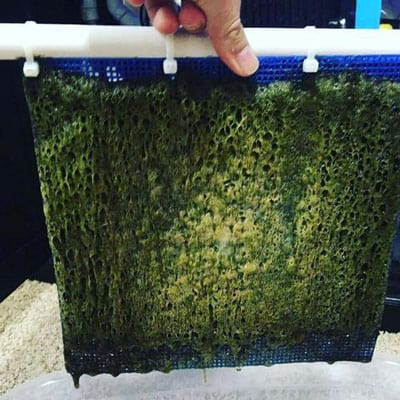
If you wish to find out more on Algae Turf Scrubbers please check out my article on them HERE. This is one of the next products on my list to fit to my system – I just have to find the room!
4. Chemical Absorption Products
Granular Ferric Oxide (GFO)
This is a product very popular for long-term Phosphate control. Most aquarists use this at an early point in the life of their aquarium after using other products to lower the phosphate to the desired level.
Think of GFO as a maintainer-type of product.
It works by absorbing the phosphate compound and chemically binding it to the Ferric Oxide. As your mass of GFO becomes used up the phosphate level will begin to rise. It is at this point you remove the GFO media, dispose of it and replace it with new.
GFO can be used in a mesh bag but it is prone to clumping so the most efficient way to implement GFO is in a reactor which allows the granules to ‘Bubble’ as the water flows through it. Once GFO is used for long-term maintenance, it can last 1-3 months between changes, depending on your Phosphate level.
Rowaphos is by far the most popular GFO. You can find it Here at Amazon.com
You can find Mesh Bags Here at Amazon.com
You can find a suitable Media Reactor Here at Amazon.com
Aluminum Oxide
This is another common product and it is mainly used for rapid phosphate removal. You have to be careful using this product, as with any rapid change in water chemistry, you can send your aquarium into shock and cause your tank to crash.
This product also absorbs the phosphate compound and binds it to the Aluminum Oxide, but rapidly. Usually, this product will need to be replaced weekly.
Aluminum Oxide does not clump together like GFO so it can be placed into a mesh bag and added into your sump or aquarium until it has lowered your Phosphate to the required level.
This product is used more to lower your Phosphate, and then GFO will be used to maintain that desired level.
PhosGuard is the most popular Aluminum Oxide. You can find it Here at Amazon.com
Liquid Phosphate Removers
Products such as Blue Life Phosphate Rx, Brightwell Phosphate-E and Ultralife Reef Liquid Phosphate Remover chemically attract and bind the phosphate and precipitate it out of the water.
This is where it allows the liquid binding agent and its attached phosphate compound to come out of dissolved form and become a solid, at which point your protein skimmer and filtration media will collect it ready for removal by you.

Most of the liquid phosphate removers work best when added to the area in which your protein skimmer is located. As the liquid binds your phosphate it will instantly be removed. Any liquid that doesn’t make it straight into the skimmer will be caught and removed later.
You can find these products at Amazon.com:
What Are Phosphates In The Aquarium?
Phosphates are one form of the phosphor compound. They are an organic salt that is found in all living things. Your aquarium is an enclosed ecosystem and your levels of phosphate will slowly build over time if you do nothing to remove them.
Some level of phosphate is beneficial, but if allows to build up over 0.05ppm you could being to see increased algae blooms and slow coral growth.
How Does Phosphate Affect an Aquarium?
High levels on phosphate in a saltwater aquairum will slow coral growth by inhibiting the corals ability to absorb calcium from the water used to build their skeletons. It is also a major food source of algae which encourages algae blooms that can starve the aquarium and corals of light and oxygen.
Lets look a bit deeper in to each of these:
1. Slow Coral Growth
Once phosphate begins to reach levels above 0.05ppm it begins to inhibit the precipitation of calcium carbonate from the water. When a coral like Acropora, Montipora, or Torches, for instance, wishes to build their skeletons they consume calcium carbonate from the water as one of the main building blocks.
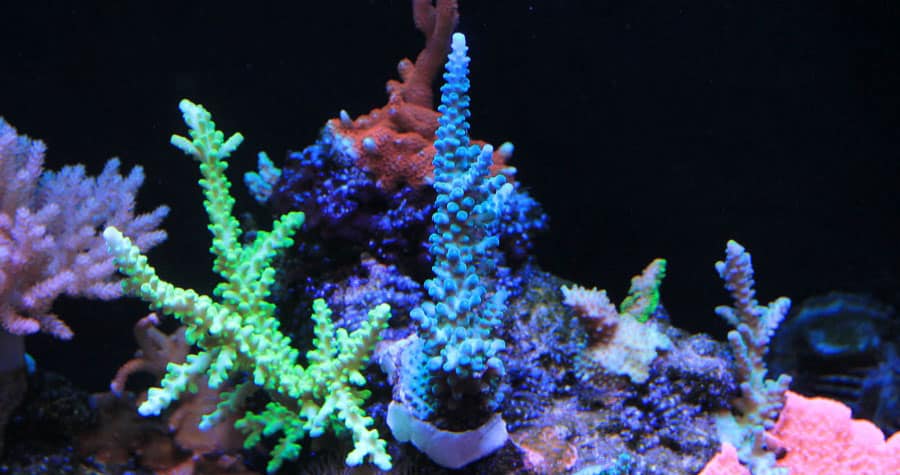
When phosphate levels begin to inhibit this uptake of calcium carbonate the coral stops growing and can even die if it is unable to consume enough calcium carbonate from its surrounding environment.
This was what was happening to me. My phosphate was at 0.1ppm which didn’t seem high, but it was enough to make my corals grow at a snail’s pace! Once I tested and found this I lowered my phosphate to 0.03ppm and my coral begin growing rapidly.
2. Increased Algae Growth
Phosphate is loved by plant-based organisms and when it is available in high enough quantity in our aquariums they can fuel rapid and sometimes fatal algal blooms. Not only do the algae blooms look hideous and can be a major battle to overcome, they can smother corals to the point of death.
Luckily for us, we can use algae’s love for phosphate to our advantage by growing and disposing of algae in a Refugium or Algae Turf Scrubber. Keep reading to find out more about these superb additions to an aquarium!
If you find you are having excessive algae growth and your corals seem to be growing slowly, you may no understand which parameter you need to test for!
Where Does Phosphate Come From In An Aquarium?
There are three main sources of introduction to our aquariums:
1. Fish Waste/Detritus
Fish waste and dead or decaying matter will all release phosphate into the water. As these items break down, they release the phosphate that is bound up inside them into the water column.
The more fish you have in your aquarium, the more excrement and detritus you will have, therefore the more your maintenance and phosphate management techniques have to deal with to prevent the phosphate level from rising above the acceptable limit for your type of aquarium.
2. Fish Food and Over-Feeding
Fish food, especially flake food, has always been known to be high in phosphate. Over-feeding is a sure way to have your phosphate level begin to increase. Just as waste and detritus above, any uneaten food begins to break down and it releases its trapped phosphate into the water.
3. Poor Quality Fresh Water
Unfiltered city or well water is usually the main culprit for introducing phosphate into your aquarium. The use of a maintained and high-quality RO/DI water filter system will ensure you have water with no pollutants or phosphate for use when adding ANY water to your aquarium, be it via the Auto Top-Off System or when making a new batch of saltwater for your water changes or the initial aquarium fill.
What to be Aware of When Lowering Phosphate in an Aquarium?
Some phosphate removal products can rapidly remove/lower your phosphate. This sudden change can shock your aquarium inhabitants. Test your water then decide how much you want to lower phosphate for this week, then dose accordingly. Slowly repeat until you have your desired phosphate level.
Once you have reached your desired level maintain using GFO or just regular water changes, depending on how much your phosphate increases each week/month.
The maximum recommended rate for phosphate removal is no more the 1ppm per day, especially if your aquarium has had a high phosphate level for more than a few weeks.
Take your time and allow the phosphate level to gradually reduce and allow your bio-system time to change to the reducing levels.
How Do You Test For Phosphate In Aquariums?
Phosphate in an aquarium can be tested using a phosphate test kit or the digital Hanna Checkers. The Hanna HI1713LR measures 0-2.5ppm and is good for fish-only tanks, whereas the Hanna HI774 ULR measures 0-0.09ppm with greater accuracy in the low end. Perfect for mixed reef and SPS dominant tanks.
In my opinion and that of many other experienced aquarists, there is only one true test kit: The Hanna Phosphate Checker Series
Select the Checker that matches your phosphate level. Each Checker measures to a specific range of Phosphate.
The Hanna HI713 LR (Low Range) Phosphate Checker is best used for Freshwater or Fish Only aquariums where the Phosphate levels being tested for can be higher. The LR checker is not able to test low enough for any aquarist keeping corals, especially LPS and SPS.
This Checker measures in the 0 to 2.50ppm range
Hanna HI774 ULR (Ultra Low Range) Phosphate Checker is used to test for the absolute lowest level of Phosphate in your aquarium. When your level is too low for the LR tester, this Checker measures down into the very low range allowing you to test for even the smallest traces of Phosphate. This is a great device for the experienced SPS keeper who wants to keep their Phosphate at a very accurate and low level.
This Checker measures in the 0 to 0.9ppm range
All of these testers use the Orthophosphate Analysis Method which is a way to test for phosphate without using a prepared sample involving a digestion acid. The Hanna Checkers use a combination of an Ascorbic Acid, an LED light source and a Silicon Light Detector to provide you with a simple, accurate and easy-to-use tester.
Most of the other test kits on the market are unable to test in a range low enough to be of any use to coral keepers.
==> You can view the entire range of Hanna Checkers HERE at Amazon.com <==
To Finish
The key to keeping phosphate low is a multi-angled approach. Good aquarium maintenance, quality water filtration, and a low aquarium bio-load will keep your phosphates low.
Maintaining this by using a product like GFO will see you well on your way to rapidly growing, colorful and healthy corals.
Further Reading
Some of my other articles you may find helpful:

